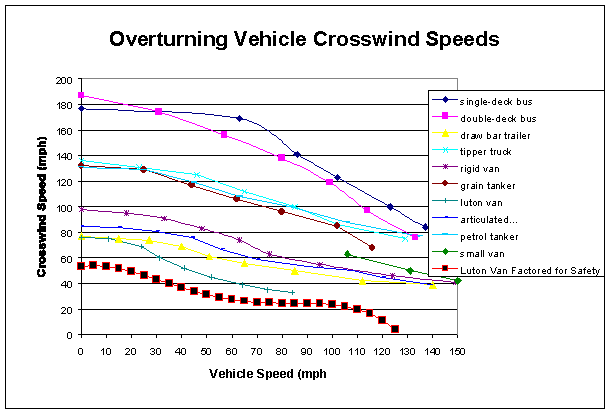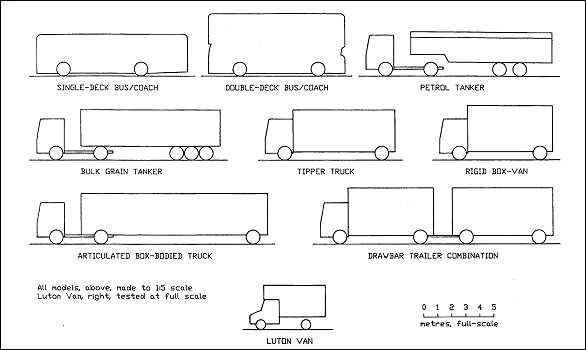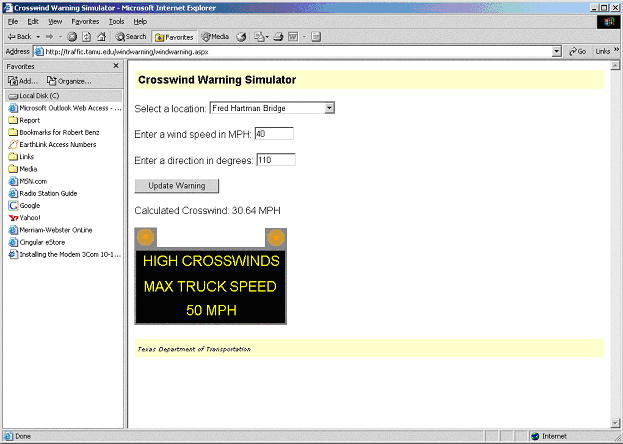Documentation of Active Warning
Device for High Winds on Area Bridges
Request: Develop a methodology or criteria to assist transportation
and law enforcement on when to warn, restrict or close area bridges based
on vehicles type due to high winds.
Approach: This methodology was developed to provide a systematic
means of determining when to restrict and/or close a bridge due to high
winds and vehicle type. Some area bridges are equipped with wind
speed and wind direction sensors that deliver real-time information to
transportation officials and law enforcement via the World Wide Web.
Trucks and high profile/high center of gravity vehicles have the highest
probability of overturning during high winds due to their large surface
area to weight ratio. Utilizing research from wind tunnels tests
on several different high-sided vehicles a model was developed to provide
decision criteria to transportation and law enforcement officials (1).
The wind tunnel tests were conducted on a variety of high-sided vehicles
at different wind speeds and different vehicle speeds on empty trucks and
no allowance for driver reaction or suspension with crosswinds 90 degrees
to the roadway. These tests yielded a series of curves which provide
the overturning wind speed at a given vehicle speed. The researchers
suggested a 2:1 safety factor. “Doubling the calculated aerodynamic
overturning moments accordingly would give critical wind speeds approximately
30 percent lower than reported in Figure 1.”
The vehicle most vulnerable vehicle to overturning is a Luton van (See
figure 2). Using this worst-case scenario of the Luton van with a
30 percent reduction in wind speeds produced the bottom curve in Figure
1. Utilizing this curve as the basis of speed reduction and road
closure, several other criteria were put in place. First, trucks
should be treated separately from other vehicles. Second, vehicle
speeds would be reduced from the posted 55 mph speed limit. Third,
that 20 mph was the lowest speed a driver would be reasonably be expected
to travel, which was based on 20 mph school zones. Finally, law enforcement
would not subject its people to dangerous conditions of hurricane force
winds and that the entire road would be closed with a 70 mph crosswind.
A web application (http://traffic.tamu.edu/windwarning)
was developed to automate the methodology. The operator enters the
location of interest, wind speed and direction at that given location as
obtained from the TxDOT environmental website (http://www.hcoem.org/txdot)
into the form as shown in Figure 3. The crosswind component is calculated
and the resulting the advisory truck speed provided. It is assumed
that this process would be automated and directly integrated using the
weather sensors for input and the DMS signs.
Process: Given a wind speed and direction, the position
of the bridge with respect to due north. A series of calculations
are conducted based on site-specific locations. First, a crosswind
90 degrees to the roadway is calculated using the vector component.
This calculated crosswind is then compared to the bottom curve in Figure
1 providing an advisory truck speed. The criteria outlined above
are utilized to provide restrictions and closure criteria.

Figure 1. Calculated Crosswind Speeds vs Overturning Vehicle
Speeds

Figure 2. Example of Vehicles Studied
Summary: The following criteria are utilized for restricting
and closing area roadways due to high wind conditions.
· Assumed calculated crosswind component normal to the roadway
· Assumed worst case vehicle (Luton Van) unladen (empty)
· Safety factor of 2:1 for overturning moment (approximately
30% reduction in wind speed)
· 20 mph is lowest reasonable travel speed
· Truck speed reduction (55 to 20 mph) is based on Figure 1
· Road closed to all traffic at calculated crosswinds of 70
mph
Potential Problems: Law enforcement might not stay out
in high wind conditions say above 50 mph calculated vector cross winds
(actual winds could be higher depending on direction). Barricades
and other devices could become a hazardous projectile in high winds.
Reference:
1. Carr, G.W. and M. J. Rose 1994. Cross-Wind Stability
of Vehicles on Bridges. Selected Papers from AUTOTECH ’93.
Safety and the Automobile 1:16-19.

Figure 3. Sample of TxDOT Crosswind Warning Simulator
|
Texas Department of Transportation
|


